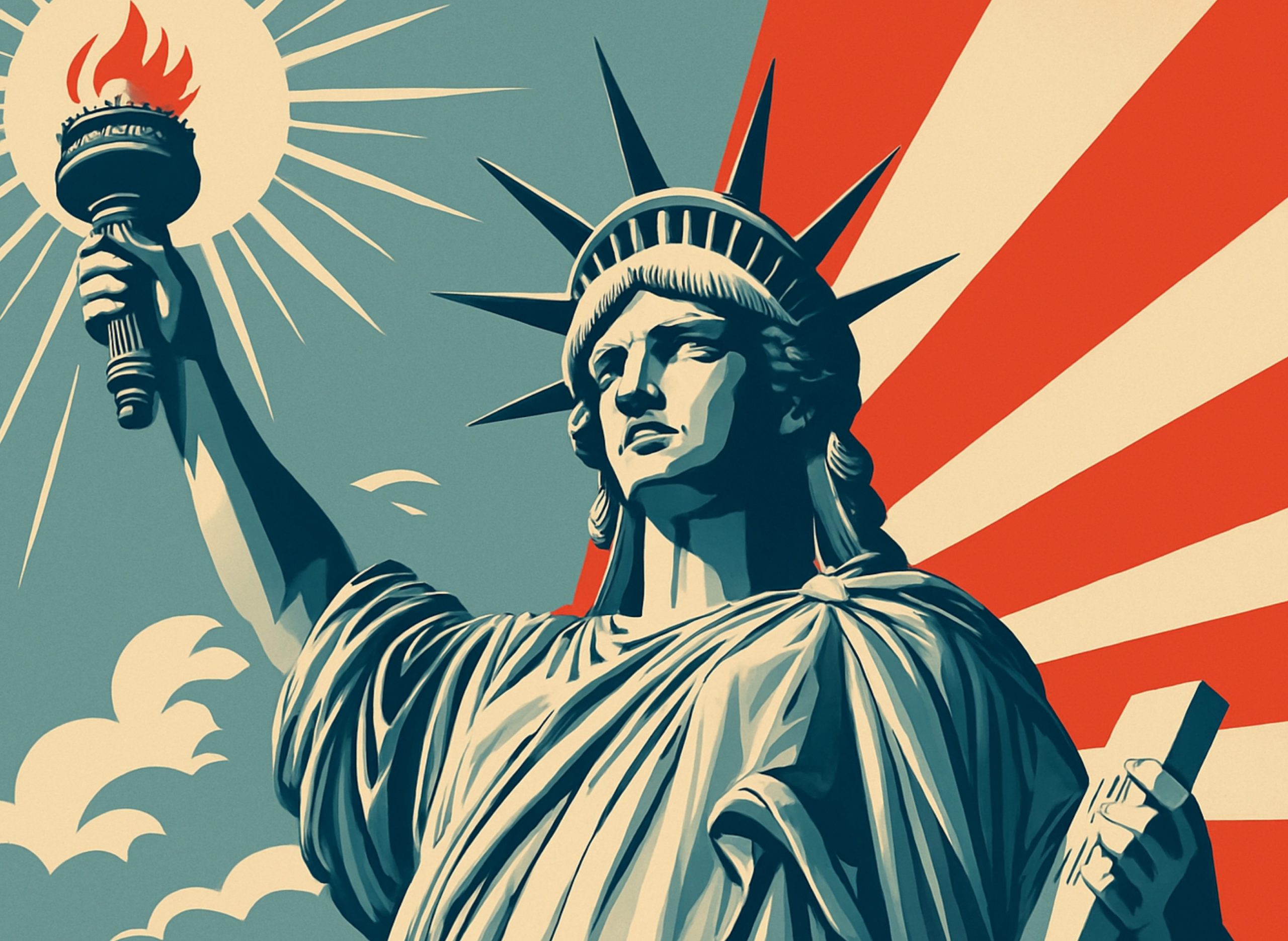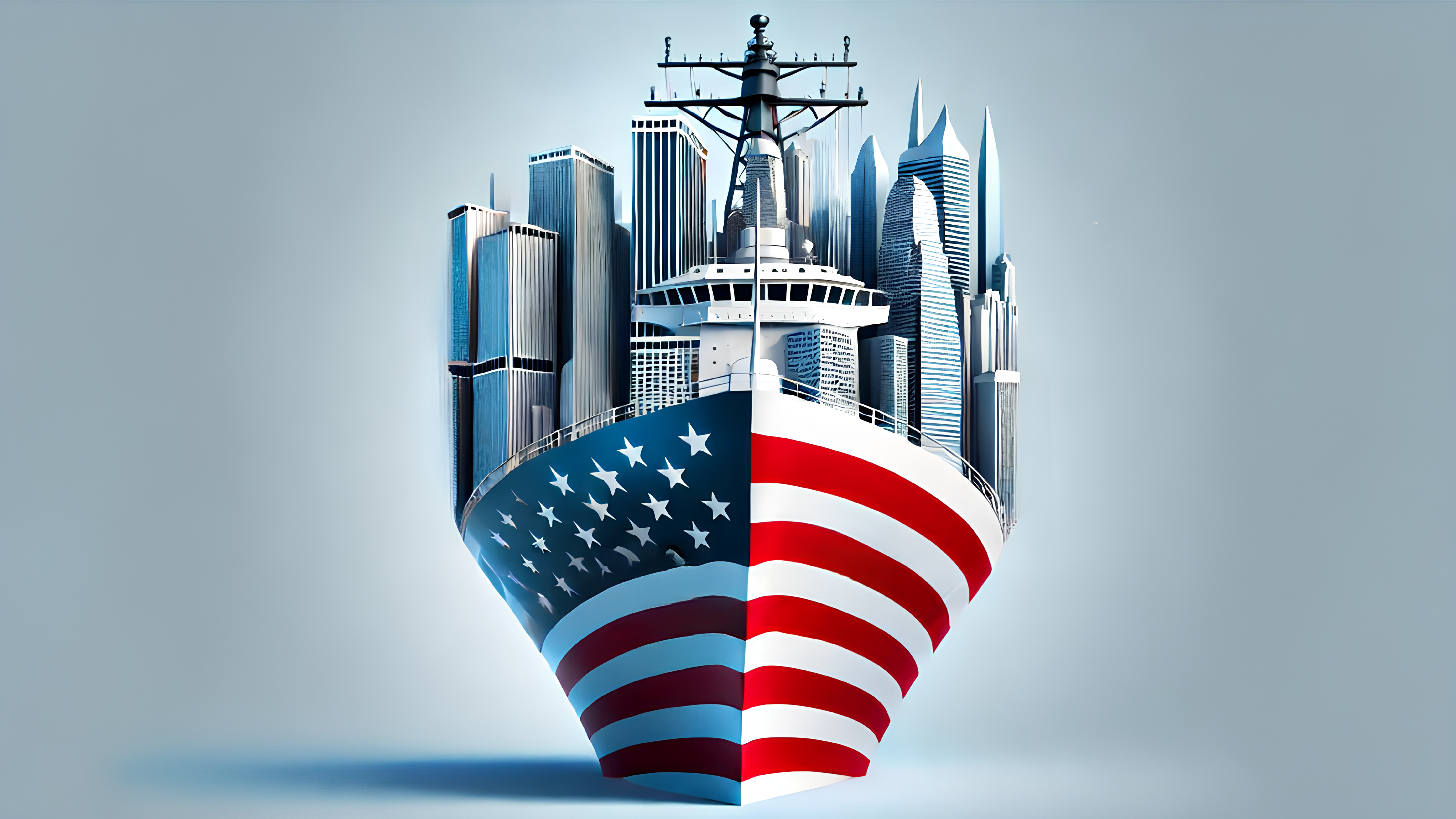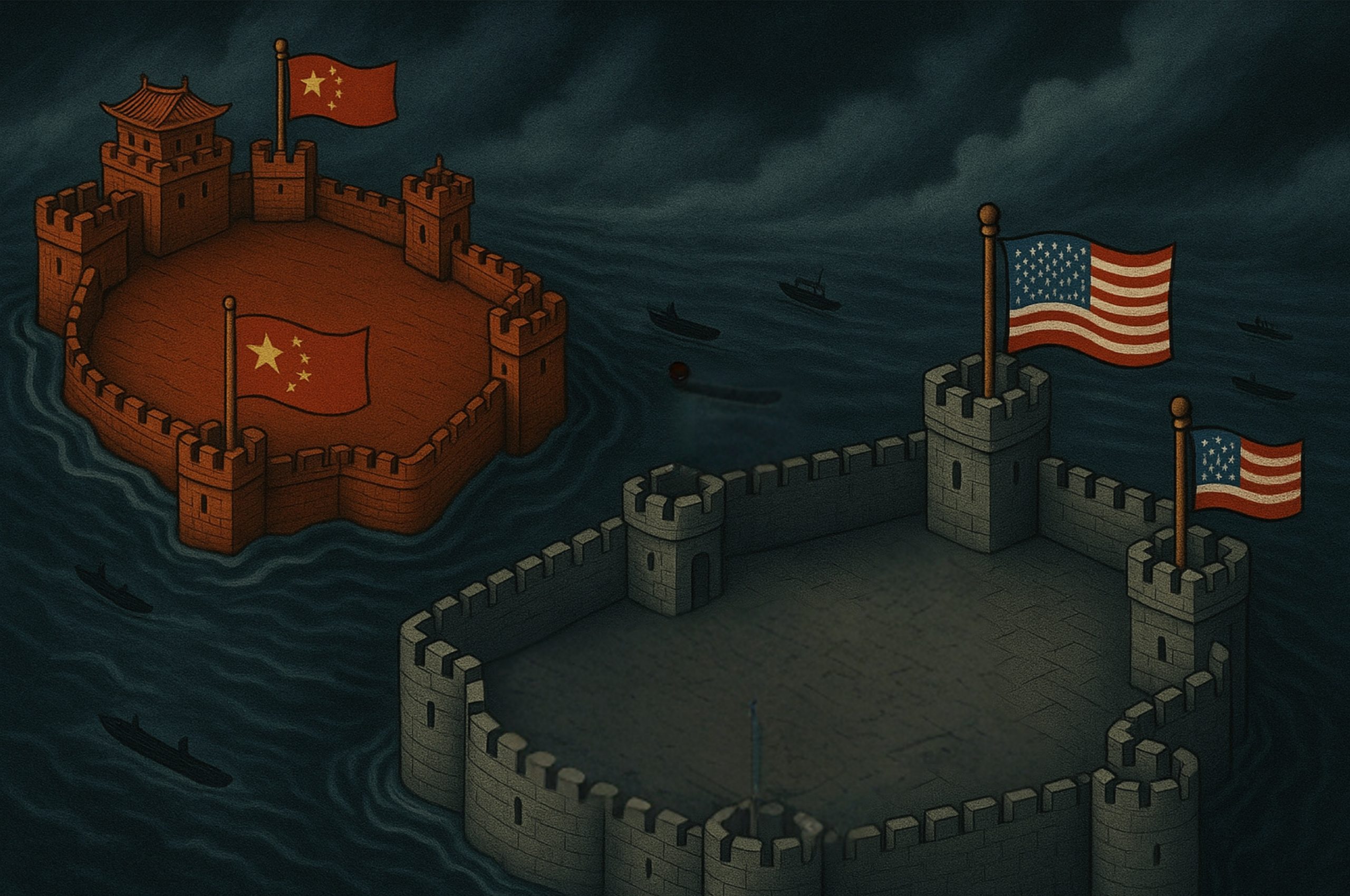

America's Universial Values
Evolving American values have continuously shaped its foreign policy.
By | John Giallorenzo,
AUGUST 10, 2024 | 09:24 PM

The United States has always been a nation of values, even as those values change and adapt with time. The fundamental cultural values of the United States are enshrined in the Declaration of Independence and the Constitution. The diplomatic values of the United States are intentionally less defined but are heavily influenced by American culture. United States foreign relations are a complicated dance between the pragmatic values of diplomacy and the absolute values of its founding documents.
As one of the few democracies in an era of monarchy, early American foreign policy sought to foster respect from the powers in Europe. This was done in many ways; the Neo-Classical grandeur of Washington D.C. was not purely done for domestic audiences, for example. America’s emphasis on having a large and capable navy also helped garner respect in an age where naval dominance was not totally one-sided. Even into World War I, the United States was still interested in the respect of its European partners. Instead of being treated like a colonial nation with its soldiers being led by European generals, the United States demanded that its soldiers fight under its own commanders, highlighting the fact that the Europeans were in no position to do otherwise.
America’s first overseas war was against Tripoli, a small country in North Africa that was part of a coalition known as the “Barbary Pirates.” This coalition made money by raiding the shipping lanes in the Mediterranean and ransoming the crews, cargo, and ships back to their homelands. To simplify things, many countries paid an annual fee to be left alone, but in 1801, Tripoli raised the fee. Thomas Jefferson refused to pay. Instead, a claimant living in Egypt was given funds to hire mercenaries, and with the support of the United States navy and marines, was able to take the city of Tripoli. This showed the nearby European nations that the United States was not going to be pushed around, even halfway across the globe.
The other major value of the era was loyalty. Many in America felt that because of France’s assistance in the American Revolution, the United States should support France as best it could. However, many in the United States government, including founding fathers such as George Washington and Thomas Jefferson, felt the United States should remain unbound to any European state. To them, Europe was a turbulent and messy land of schemes and infighting. Any attempt to bind two countries together would either end in failure or see one of the two countries subordinated to the other.
Despite the belief that official alliances were unwise, the desire to return the support France gave to the early United States was strong enough for Thomas Jefferson to make the controversial Louisiana Purchase, giving Napoleon a large infusion of cash to fund his war effort and also denying most of the American interior to the British, who otherwise would have occupied it. While some questioned if Jefferson had the authority to make the agreement so quickly, he ultimately received congressional approval.
These two factors combined in the War of 1812 when the United States fought the British over a long-running dispute over the practice of impressment, a British practice of stopping ships at sea and forcibly conscripting sailors into the Royal Navy. They claimed to only be returning British deserters, but there were widespread claims that Americans were being forced into service as well. The British needed sailors so badly because they were embroiled in the Napoleonic Wars against France, which posed a serious threat to British naval superiority. The decision was made to challenge the British and prove that the United States was not going to be walked over on the global stage. Although the war is mostly forgotten today and failed to achieve its main objectives—the British themselves banned impressment shortly before the war began, unbeknownst to the Americans—it did show that the American military had teeth.
Taking advantage of these “teeth,” the United States publicly forbade any further European colonial expansion in the western hemisphere with the Monroe Doctrine. While it wasn’t clear if the United States could enforce the threat in its entirety, it did force European powers to consider American intervention in any future campaigns. At the same time, the British also began discouraging further colonization of the New World.
The 1800s were a very important time for American foreign policy. At home, the country was expanding rapidly, its population was increasing, and its government institutions had largely solidified after the revolutionary 1700s. Because of this, it felt more comfortable being an actor on the world stage rather than a reactor. This was the first full century of American history, and as such, the values that guided it fluctuated. Broadly, the main values of this period were territorial integrity and a sort of humanitarian development. At the time, there was a widespread belief that industrial development was inherently humanitarian as it often brought increased wealth and a higher standard of living to the areas involved. We see a similar stance today with China’s industrialization being praised for raising so many millions out of poverty.
A quirk of the country’s colonial past, and the limited knowledge early European colonists had of North America, was that the colonies were technically granted land all the way across the continent. While the British had started pushing back against this original grant before the revolution and many states had given up their western claims early in United States history, the idea that the United States naturally stretched “From Sea to Shining Sea” was embedded in American culture.
Initially, this led to a series of conflicts often known as the “Indian Wars,” where the U.S. Army fought various native tribes to make way for American settlers. These conflicts were small in scale but often quite bloody. However, the focus quickly shifted from the Native Americans to the Mexicans who owned much of what is now the U.S. Southwest.
After defeating Mexico in the Mexican-American War and purchasing a slice of land along the new border, the United States achieved the majority of its modern-day borders. Feeling secure in its boundaries, it began to focus outward. It partnered with the United Kingdom to destroy the intercontinental slave trade that had been siphoning the population of West Africa into bondage in the Caribbean and American Southeast for over a century.
While this no doubt helped save countless lives, it was a symptom of a heated debate going on within the United States. Its cultural values of liberty, equality, and freedom for all were at odds with the sheer economic value of slavery. After brief hope that the banning of the slave trade would bring a natural end to slavery, the abolitionists decided to take a more proactive stance. Electing Abraham Lincoln to office, despite his claims that he had no intention of outlawing slavery, he was an outspoken opponent of the practice. The southern leaders were skeptical of his claims and preemptively withdrew from the Union.
During the Civil War, Lincoln made it clear to the Europeans that a formal acknowledgment of the Confederacy would be considered an act of war against the Union. A threat that was assuredly not empty, as the Union rapidly became one of the most militarized societies on earth at the time with a large and capable navy. The United States may have appeared like a collection of partnered states, but it now became clear to everyone that it would not tolerate infringement of its territorial claims.
With the conclusion of the Civil War, the focus of the United States initially shifted inward, reintegrating the South and reeling from the assassination of President Lincoln. However, it gradually came back to the world stage as outside events drew its attention. First was the continued turmoil in Cuba as the Spanish Empire fought a heated guerrilla war against separatist insurgents. While there were loud demands from the American public to intervene, the government was reluctant to fight a European state.
In an attempt to appease war hawks at home, the U.S.S. Maine was sent to Havana both to show American displeasure at the continued turmoil on the island and to investigate some of the more outlandish claims being made in the American press. Unfortunately, before it could do much of either, it exploded and sank, with its entire crew going down with her. Still, the U.S. government refused to go to war and instead sent a team to determine the cause of the explosion. When the cause was confirmed to be from an external attack, there could be only one response.
The Spanish-American War was a short conflict that saw the United States assume control of several Spanish colonies and ensure the independence of Cuba. It also allowed the United States to become one of the few, at the time, non-European entities to independently defeat a European power. No time was wasted in investing in Cuba, which would see significant American investment and tourism for generations to come.
Possessing the Philippines made trade with China, one of America’s leading importers, easier and safer while also putting the U.S. close enough to engage with China as Europe began eyeing the ancient empire. After a series of defeats and long-running trade and cultural disputes, Chinese civilians began taking up arms and attacking outsiders wherever they found them. Chinese who adopted Christianity or were too European for the gangs’ liking were also executed, often publicly. The groups came to be known as Boxers in the West, and calls for the Chinese government to rein them in fell on deaf ears.
As the Boxers grew in strength and numbers, they laid siege to the embassy quarter in Beijing, sparking an international response. United States soldiers tasked with guarding the embassy in Beijing fought alongside the defenders of the other embassies while American warships and soldiers were deployed to take part in the relief expeditions. After fifty-five days, the European, American, and Japanese relief force reached the capital and broke the back of the Boxer movement.
Discussions were had about dividing China among the victorious powers, similar to how Africa was divided between the European powers. The United States was openly opposed to this, partly due to its stance against colonialism and partly because this would restrict access to much of the Chinese market. Instead, they proposed enforcing a policy of free trade onto China but otherwise allowing the Chinese government to maintain its authority. This would allow any nation to trade with China instead of requiring special permission from the central government. Ultimately, free trade won out as few of the participants could seriously defend a colony in China and felt maintaining an independent China as a trading partner was more valuable. Coming so close to the victory over Spain, and with the backdrop of the Monroe Doctrine, its actions in the Boxer Rebellion represented a small but serious step as a leader on the world stage.
While many in the United States protested America’s burgeoning influence on the world stage, it did not stop the slow metamorphosis into a great power. Instead, the United States began using its new influence and standing to champion democratic values and eventually nationalism in a more traditional sense. As with all things, these efforts started off clumsy and with mixed success.
Specifically, the United States began intervening heavily in Latin America and the Caribbean. Ostensibly, this was done to improve local governance, but it often served American business interests at the expense of most else. It also tended to create local insurgencies that harassed American and local security forces and occasionally bled over into the mainland U.S. as well. During this period, there were many Americans funding and supporting these insurgencies as an act of protest against America’s growing international presence.
As the United States was experimenting with interventions, the world marched on around it, directly into World War I. In the beginning, the United States was not ready to intervene directly in a large European-scale conflict, even if it was broadly sympathetic to the Entente. Specifically, many felt that the United States had no obligation to get involved. However, as the war dragged on and repeated transgressions against the United States occurred, it became increasingly difficult for the country to turn the other cheek. While the United States was only in the war for a short period of time, it was determined to show itself as an independent actor and voice its opinions on any potential peace treaty.
Regrettably, not all dreams come true, and the eventual Treaty of Versailles had so little input from the United States that it was never ratified; instead, a separate treaty ended the war between the United States and Germany. During the interwar period, the United States tried to maintain peace by using its economic leverage to cow various non-democratic nations. This was able to mitigate some conflicts, but it was largely ineffective at its goal of creating a lasting peace.
The United States also pioneered the concept of regulated naval military sizes, hosting a series of naval conferences where the globe’s major powers agreed to keep their navies at certain sizes to prevent arms races and the appearance of threatening their neighbors. Again, this had some effect in the short term but was almost entirely abandoned within twenty years.
Europe is often considered the center of World War II, but the United States was more concerned with Japan in the interwar years. A series of diplomatic crises between the two countries raised tensions across the Pacific in the lead-up to the attack on Pearl Harbor, including smaller-scale attacks on American soldiers in China. When war broke out in Europe, the United States again saw itself under no obligation to intervene as it had no formal alliances with the European states. That did not stop Germany or Italy from declaring war on the United States shortly after the attacks on Pearl Harbor.
After the war ended, the United States was again determined to play a pivotal role in the peace and usher in a new period more in line with its values. This led to the United States creating democratic governments in the defeated powers and any ancillary parties that they controlled. It also led to a rabid push toward decolonization, with the United States openly supporting nationalist movements in many colonial regions across the globe, such as the African National Congress in South Africa or supporting Egypt in the Suez Crisis.
This did at times create friction both with U.S. allies who wanted to retain colonies, notably France with its conflict in Algeria, but also with its own value of democracy. Some of the nationalist movements had a genuine desire to form a democracy, but many of them truly sought to replace colonial rule with their own personal rule. The post-war United States struggled significantly with whether it was better for a region to be ruled dispassionately by foreigners or cruelly by locals, a question that still remains mostly unanswered.
The postwar world also brought with it the Cold War, which saw the United States ascend over the traditional Great Powers to champion the western “Free World.” It gradually became accustomed to acting on the world stage, going from asking the United Nations for permission to defend Korea to unilaterally carpet-bombing North Vietnam and launching incursions into Laos and Cambodia. It promised to defend anyone who opposed communism and made good on the promise, even when many Americans questioned if such a blank check was the best policy, especially when a fresh wave of Latin American interventions brought about incredibly non-democratic regimes while pro-democratic demonstrators in Hungary and Czechoslovakia were crushed by Soviet forces. Despite the concern and sacrifices made during the early postwar period, the United States emerged from the Cold War as the sole superpower following the rapid disintegration of the Soviet Union.
America has numerous cultural tenets that influence how it behaves diplomatically. Of those, the two most well-known would likely be its value of individual freedoms and broader human rights. In many ways, they are very similar values and can even be the same depending on the circumstances. Individual freedoms essentially boil down to the ability for an individual person to choose how they live their life. Human rights more broadly are a series of rights enshrined in various laws and international agreements that define the minimum conditions that countries must provide for their citizens, such as access to food.
The United States is also known for its love of democracy and the rule of law that goes with it. American elections are followed across the world and even televised in countries that would be considered adversaries. While the United States has had mixed results in its efforts to support democracies abroad, it has remained an unquestioning champion of the process for over two hundred years. Democracy cannot exist without the rule of law, an obedience from the government to the laws as they are written. In many cases, American efforts to support democracy take the form of supporting the rule of law, either by sanctioning corrupt officials or helping to fund local law enforcement agencies.
A pillar of American culture from its inception has been the ability of average people to rise to great heights. To this day, the concept of meritocracy is widely beloved by many Americans, and any perceived threat to it can be met with intense backlash. A component of this is that your fate is your own. You can start a business, run it your way, and reap the rewards of becoming a local favorite, or handle the fallout of going out of business.
It’s no secret that meritocracy was not always extended to everyone within the boundaries of the United States. Over its history, there have been several movements from groups who wanted to be more included in American society. The most famous of these was the Civil Rights Movement of Martin Luther King Jr. and the broader black community. While these movements have been successful in many cases, they have not been without struggle and challenges. However, despite the often difficult journey, American society has embraced many groups that were once scorned.
Free enterprise has also been a mainstay pillar of American culture and perhaps one of the earliest to influence its foreign policy. One of the factors that made the colonies so prosperous before independence was how easy it was to open and operate a business. Because of the scale of businesses and the advanced methods that are used to produce goods, it can be difficult to find the middle ground between ease of operation and ensuring the safety of the communities the businesses operate within. Even so, there are many champions ensuring that the free market in the United States remains free and thus within the citizens’ control.
This led to the creation of the “American Dream” very early in its history. To many of the poor and lower-class people of Europe, the idea that you could go to the United States, start a small farm, and have your grandchildren live in mansions selling potato chips was almost a fairy tale. It caused millions to sail across the Atlantic and build homes across the continent, opening businesses wherever they went. Many in Asia were living in similar conditions and began arriving on the West Coast in even larger numbers. While only a small handful of families would go on to be wealthy billionaires, many were able to achieve a higher standard of living than would have been possible in their home country.
From its inception, American foreign policy has sought to spread American values. It took many decades before any tangible results could be seen, but from there, things began to change rapidly. The concept of a republic or any other democratic system seemed like a silly dream in 1776, but by 1900, even the most autocratic countries were under increasing pressure to adopt democratic reforms. Those that didn’t, such as Russia and China, faced uprisings and civil wars against a population that no longer tolerated being ruled without input.
Very few groups actually received material support from the United States, but standing as a successful democratic nation showed that it was possible. From there, many began to ask, “Why there and not here?”—a question despotic regimes across the globe struggled to answer. Even today, the small holdouts of autocracy must pay at least lip service to democracy and spend tremendous effort telling their populations why democracy isn’t right for them. On the contrary, the United States has often pushed its partners to be more democratic, requiring certain reforms or conditions to be met prior to any agreements being made, even going as far as to fund institutions in other countries so they can better support the local government.
The United States was also not particularly quiet about its love of free trade, often supporting free trade policies internationally and bilaterally when dealing with other nations. On several occasions, it even fought or intimidated other countries into allowing the unrestricted flow of trade across their borders. Early in American history, it sought to have a large navy not simply to protect its coastline but to ensure that its trade ships were protected and unbothered regardless of where they went. It may seem strange to us today, but back then the flag a ship was flying was incredibly important in determining if anyone would help you. The only way to guarantee your ships would have backup was either to make sure you had warships nearby or you had an agreement with someone who did.
Its desire to have consistent and reliable trading partners could also drive altruism, such as the Marshall Plan. After the destruction of World War II in Europe, Japan, and Korea, there was serious concern in the U.S. government that the population would turn to radicals with gilded promises—radicals who were often either explicitly anti-American or at least endorsed highly restrictive trade between nations. Something that would have hurt the U.S. economy as well as set a dangerous precedent for other nations to follow. So, it was decided that the United States would finance the reconstruction of these areas so that these radical politicians could no longer prey on the desperation of those left in the wake of the war.
This isn’t to say the United States has no problems or missteps. As long as the United States has existed, there have been those within it claiming it was going down the wrong path. In some cases, these criticisms were listened to, such as those who argued the Articles of Confederation needed to be replaced. A more recent example would be the Civil Rights Movement, which made tremendous strides in public relations and ultimately achieved its objectives.
On the other hand, there are many examples where the malcontents were not listened to. In some cases, the same issue has critics on both sides saying either that things have gone too far or not far enough. While the Civil Rights Movement was leading marches and sit-ins, there were groups advocating for the continuation of segregation who were ultimately defeated.
This tradition of having agitators on both sides of an issue is highlighted in the lead-up to the Civil War. Slavery had detractors since before America gained independence, but the rhetoric and tension over the issue continued to increase year on year. The popularity of openly abolitionist parties in the North and hardline pro-slavery parties in the South led to not only heated political debate but outright clashes in Congress. Eventually, this led to clashes on the battlefield between the two sides until only one was left standing.
Today, this process mostly focuses on inequality of various types, with income inequality currently taking much of the attention. Ultimately, only time will tell what the outcome will be and how it will be remembered. Although its current cultural impact is indisputable, considering how normalized discussing income inequality now is and how many wealthy individuals publicly apologize that they make more than average.
Criticisms have also come from outside the United States. Generally, the more the United States appeared on the world stage, the more criticism it received, and thus, the majority of its foreign criticism is relatively modern. The most prevalent criticism revolves around America’s tradition of intervening in foreign political affairs.
Beginning in the Caribbean and Latin America, it is now something people around the world can relate to and recite fairly consistently, especially in the Middle East and Southeast Asia. The underlying issue is that the United States gets involved in the domestic political process, often with force, leading to an artificial resolution. This removes the need to compromise and work with the other members of that country’s society and sometimes even its government. Giving government branches the ability to ignore constitutional requirements and consultation of other branches. When these roadblocks are removed, it gives the government the ability to commit serious crimes such as human rights abuses and rampant corruption.
There have also been many concerns raised about the concept of “cultural imperialism.” This is the notion that smaller countries gradually lose their traditions, values, and cultural identity as their children grow up learning English, watching American media, and being immersed in American ideals. As this has only really kicked off with the widespread adoption of the internet, it is hard to tell how impactful exposure to American culture really is and what the long-term implications will be. It is also unclear if individuals are embracing American culture out of a genuine agreement with its values or if they truly are going along with it due to a lack of exposure to any alternatives. Unlike the concerns about American interventions, the fear surrounding “cultural imperialism” tends to come from a small group of countries that were already at odds with the United States or its values and often goes hand in hand with more government control over local media and education.
The United States has a long tradition of generations assigning themselves values and causes that they rabidly support. In some cases, these come from existing American values, such as the Freedom Riders taking their summer vacation to teach literacy and math courses to disenfranchised southern voters in the 1970s. In other cases, their values and causes gradually become universal values of the United States, albeit often only temporarily.
How these are chosen is somewhat mysterious to this day, but the education system has long been viewed as the most likely culprit, hence the decades of politicians complaining about the education system. However, this is unlikely for several reasons, the most prominent being that the United States does not have a single education system. It has more than fifty education systems that are only loosely related to one another. Each state has the final say on what it teaches and how it teaches it. America’s secondary education system is even more decentralized, with the states operating their own universities, private universities operating with little to no oversight, and at least a handful of federal universities operating under the direct authority of Congress.
Because of the very uncoordinated way Americans are educated, universal values often come from cultural centers rather than educational centers. Movies, TV shows, books, and public gatherings like popular festivals and concerts are the main ways Americans form consensus opinions. This is also part of how America became so polarized, with people picking certain cultural centers over others and only becoming exposed to alternate views once consensus has already been reached. It is also why Americans and American politicians are so concerned about cultural icons and media forms. They are as important to making America, America as the education system is, and potentially more so.
The United States has always been interested in coalition building and forming broad multilateral associations. During the Revolution, it was cooperating with at least three European powers to help pressure the British on other theaters and supply its own war effort at home. While it voluntarily took a back seat when its economy was predicated on selling as much stuff to as many people as possible, it was still advocating for diplomacy and coalitions, partaking in the suppression of the Boxer Rebellion and then advocating for a unified China with free trade.
The United States proposed the original League of Nations and later the reformed United Nations, and hosts the main building to this day. It has used the United Nations as an avenue to build coalitions even in scenarios when it doesn’t need to. While many people are familiar with the United Nations Peacekeepers, colloquially known as ‘Blue Helmets,’ it is less well known that the United Nations did not have the authority to deploy peacekeepers when it was first created. The United States developed the concept at the start of the Korean War. While it was committed to defending South Korea unilaterally and was already taking steps to intervene, it proposed a resolution to the United Nations to send a broad coalition peacekeeping force to beat back the North Korean invasion. This resolution passed, and countries all around the globe sent soldiers to help, and future conflicts saw the activation of U.N. peacekeeping powers.
As American democracy promises that discussions and compromise can lead to a more effective, stable, and attentive government, American diplomacy promises that discussions and compromise can lead to a more stable, peaceful, and prosperous global system. While it is not immune to human stupidity and may not spread that prosperity completely evenly, its goal is to create a fair system for all involved.
Since the end of the Second World War, whenever something happens in the globe, all eyes turn to the United States, even when it does not want to get involved. As such, the United States has taken the lead on handling many global crises, including the recent Covid pandemic. There have been calls since the 1970s for the United States to take the lead on tackling climate change, but its track record has been mixed. There was a period when recycling and emissions limits were popular and enforced, ending smog across American cities. In the 1980s and 1990s, it was far less fashionable and only slowly gained momentum again in the 2000s. By the 2010s, it was something that was discussed, but serious efforts were few and far between. Now, in the 2020s, it looks like the United States may be ready to start making moves again, but how those moves will come about and how successful they will be remain to be seen. Perhaps a more important question will be how long the measures last, which historically has not been very long in most cases.
On other issues, the United States has often sought to rapidly form a multilateral coalition, decisively handle the crisis, and then return to the global status quo. After a long back and forth with the Europeans on who was responsible for handling the collapse of Yugoslavia, the United States stepped forward and accepted that from then on it was going to be the world police and led a bombing campaign against the Serbian forces. When Iraq invaded Kuwait, its other Arab neighbors looked to the United States for assistance, and it, through the United Nations, formed a coalition and repelled the Iraqi invasion. When Houthi terrorists started hijacking and later sinking merchant ships traveling through the Red Sea, the globe called for the United States Navy to begin convoying ships through the region. Many both in and out of the United States question American global leadership, but it is clear that in times of crisis, it is the United States that is expected, and able, to step up and tackle the challenges that face the world.
In the world of governance and international relations, there are no manuals or tutorials. Those in positions of power have nearly limitless possible ways to approach problems with three main pillars to guide them. They have legal limitations on what they can do, they have material limitations on what they can do, and they have their values and beliefs, which can both limit and drive leaders’ actions. Because of this, it is important to understand the culture and beliefs of those in power and the culture that they come from. Perhaps decisions that the United States has made over the years make more sense now, understanding the mindset and values of those making the decisions. Or maybe modern America seems more understandable given the importance of values and the long path that brought us here.
The United States has often acted with a directness that it views as efficient and reliable but tends to come across as oafish at the best of times. It can also be fairly easy to predict, to the point where random internet users can reliably predict America’s reaction to various events simply by knowing recent history. Predictability is useful as a global superpower, but it can also be an Achilles’ heel, as your adversaries can meticulously prepare for exactly what you are going to do, as the United States and Saudi Arabia have found with the Houthis.
The United States has often failed to comprehend the average person in foreign countries. This has led to disastrous attempts to support regimes that were so unpopular they had to resort to intense repression to retain power, or has led to the United States sitting back and watching as disinterested or outright hostile populations allow the American-backed or created government to evaporate in favor of something less aligned with United States interests. Only recently has the concept of “public diplomacy” been given a name, and currently, that is as much as it has gotten. Being used as little more than a marketing firm to advertise new programs or American policies, the idea of genuinely engaging with foreign populations and learning their thoughts and grievances remains elusive.
Ultimately, the United States tends to view the world through rose-tinted glasses, believing that its good intentions will ensure all its plans succeed on the first try without any hindrances. When that is inevitably proven false, it tends to resort to bashing its head against the obstacle harder and harder until one of them breaks. It will then go and sulk on its pseudo-island and lick its wounds before coming back to repeat the process ad infinitum.


